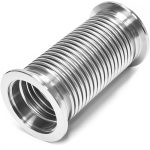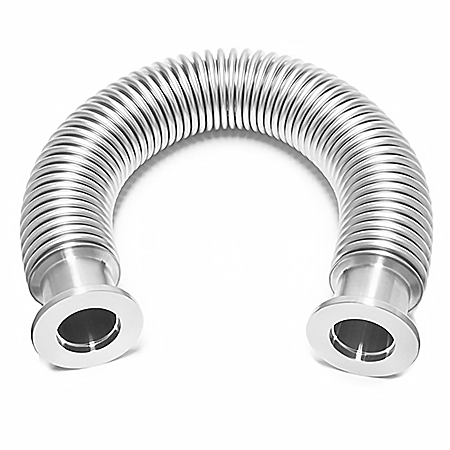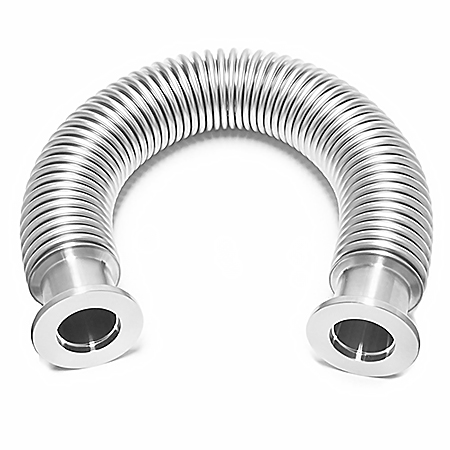
Concept of Metal Hose and Stainless Steel Corrugated Hose
Types of metal hoses and corrugated hoses
The metal hose is a flexible metal pipe connection. Has a history of more than 100 years. There are two basic types of metal hoses, which are different in design and application: divided into spiral hoses and corrugated hoses. The original design of the ribbon-wound hose was based on a spiral belt S-shaped profile wound metal belt. The profile is interlocked along the windings of the spiral coil, and the hose in the tape-wound state has high mechanical strength (such as tensile strength and tear strength). Until the 1920s and 1930s, the manufacture of metal corrugated hoses created satisfactory annular corrugations. There are two basic variants of corrugated hose, and their corrugated types are different: annular corrugated and spiral corrugated. In hoses with spiral corrugations, usually with constant right-handed coils, the pitch runs along the entire length of the hose. The annular corrugation, on the other hand, consists of a large number of equidistant parallel corrugations whose main plane is perpendicular to the axis of the hose. Hose with annular corrugation has been determined to be superior to hose with spiral corrugation.
Stainless steel metal hose structure
The corrugated hose is used to allow movement, economy, thermal expansion and vibration of flexible connection elements, and can be used as a filling hose. The starting material is a seamless or longitudinally welded thin-walled tube, and the strip is continuously welded using a high-precision shielding gas welding method. Then the bellows of the special mold are used to hydraulically make the thin-walled pipe corrugated: the hydraulic bellows expands the pipe from the inside out. The mechanical corrugation method is used to manufacture circular and spiral corrugated hoses. Typically, multiple forming pressure rollers are positioned around the tube with an offset so that they can roll the desired corrugated profile into the tube from the outside to the inside. Both corrugation methods cause the material to harden, thereby increasing the pressure and fatigue resistance of the corrugated hose. This method is used to create annular bellows hose and bellows compensator expansion joints.
Metal hose performance
The corrugated hose is leak-proof and used to transport liquid or gas under pressure or as a vacuum line. Stainless steel metal hose is also called pressure hose. Its special design achieves flexibility and pressure resistance. On the other hand, production-related testing is an integral part of the manufacturing process. It includes entry testing of starting materials as well as size, leakage and pressure testing of finished pipes.
Labideal stainless steel metal hose can withstand high pressure and provides greater tightness due to its material. The corrugated hose is pressure and vacuum sealed. The allowable working pressure of the small size hose reaches 380 bar (with a safety factor of 3 times the burst pressure). Due to technical reasons, the large size has low pressure resistance. The temperature resistance of the stainless steel model is up to approx. 600°C, depending on the pressure load, even higher values may be associated with special materials. Stainless steel corrugated hose can be used down to -270°C in the low temperature range.
Metal hoses resist high pressures and provide greater tightness due to the materials from which they are made. Their flexibility gives them tensile and tear strength. In addition, they are characterized by their corrosion resistance and pressure resistance, even under extreme conditions, such as when exposed to aggressive seawater, strong vibrations, and extreme temperatures such as in spaces or when transporting cooled liquid gases. Corrugated hoses also exhibit corrosion resistance under extreme conditions, such as pressure and tightness in seawater, transport liquids, gases, extreme hot and cold media conditions. Especially suitable for medium transportation, including metal bellows expansion joints, stainless steel metal hoses and semi-soft and flexible metal flexible pipes.
flexibility
The flexibility of the stainless steel metal hose is achieved by the elastic behavior of the corrugated contour of the hose. When the hose is bent, the external corrugations are separated, while the internal corrugations are squeezed together. The flexibility, bending performance and pressure stability of the corrugated hose depend on the selected contour shape. Generally, if the elasticity is high, choose Ω type (Omega hose wave type). Although the flexibility increases with increasing profile height and decreasing corrugation interval, the pressure resistance decreases. The semi-flexible bending behavior that is often required is achieved with a flat profile. Depending on the use of the hose, specific contour shapes for specific applications can be achieved
Install correctly
When properly installed, they have no damaged torsional strain during pressure fluctuations.
Due to the shape of their outline, they are smoothly connected to the connection fitting.
This increases process reliability during pipeline assembly and use. Therefore, ring corrugated hoses are more common, with a few exceptions.
Metal hose applications
Because of its ability to meet the high requirements for transporting hot and cold materials, this modern technology has the following main application areas:
- Electrical industry and mechanical engineering: as protective hoses for power cables or optical conductors
- As a suction, delivery and coolant hose, for example when delivering and delivering liquid gas
- Automotive industry: as an exhaust hose acting as a vibration separator for the exhaust system
- As a ventilation hose in technical construction equipment
- steel industry
- Measuring and control equipment
- Medical equipment
- Air and space travel
- Reactor technology
- Alternative energy sources (solar heat, wind turbines, etc.)
Braided metal hose around
Used for motion decoupling in vehicle exhaust systems
In order to increase the pressure resistance, the metal hose can be equipped with one or two layers of braid. The braid is firmly connected to the hose connectors on both sides to absorb longitudinal forces caused by internal pressure. Due to its inherent flexibility, the braid itself perfectly molds the movement of the hose. The hose braid consists of wire bundles wound by the right and left hands, which are alternately layered on top of each other. This not only prevents the hose from being elongated due to internal pressure, but also absorbs external tension and protects the outside of the hose. The basic material of the wire braid is usually the same as the basic material of the corrugated hose. For better corrosion resistance or economic considerations, different materials can also be selected.
Braiding also greatly increases the resistance of the hose to internal pressure. The braid flexibly molds itself into the movement of a hose. This applies even if a second braid is used, which further increases the pressure resistance. The method of attaching the braid to the connection fitting depends on the type of fitting and the need for the hose. Under rough operating conditions, an additional circular coil can be wound on the braid, or the braid can be sheathed in a protective hose.
Functional principle of metal woven mesh
The principle of thread braiding on inert pliers. When axial tension is applied to the hose, the braid reaches its extension limit. This means that the wires are closely spaced at a small crossing angle, forming a hose braid with a small possible diameter and a large possible length. When the hose is compressed axially, the cross angle and diameter increase to a large value.
It is made of stainless steel bellows with one or more layers of steel wire or steel belt mesh sleeves, which are flexible components used to transport various media. The main parts are made of austenitic stainless steel, and various pipe thread and flange joints can be used at both ends. It has the characteristics of light weight, good flexibility, corrosion resistance, fatigue resistance, high temperature resistance, low temperature resistance (-196 ℃ ~ +520 ℃), high pressure resistance, shock absorption and noise reduction, strong sealing and long service life. Widely used in petroleum, chemical, metallurgy, electric power, aviation, aerospace, papermaking, textile, construction, medicine, food, tobacco, transportation and other fields. It is used for fluid transportation, compensating the mutual displacement of the connection end of the pipeline and the machine equipment, absorbing vibration energy, can play the role of vibration reduction, noise reduction, etc. It is a modern industrial and pipeline safety flexible connection pipe fitting, so it is widely used by various industries.






